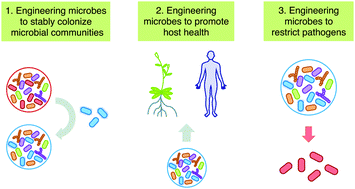当前位置:
X-MOL 学术
›
Chem. Soc. Rev.
›
论文详情
Our official English website, www.x-mol.net, welcomes your feedback! (Note: you will need to create a separate account there.)
Engineering chemical interactions in microbial communities
Chemical Society Reviews ( IF 46.2 ) Pub Date : 2017-12-06 00:00:00 , DOI: 10.1039/c7cs00664k Douglas J. Kenny 1, 2, 3, 4 , Emily P. Balskus 1, 2, 3, 4
Chemical Society Reviews ( IF 46.2 ) Pub Date : 2017-12-06 00:00:00 , DOI: 10.1039/c7cs00664k Douglas J. Kenny 1, 2, 3, 4 , Emily P. Balskus 1, 2, 3, 4
Affiliation

|
Microbes living within host-associated microbial communities (microbiotas) rely on chemical communication to interact with surrounding organisms. These interactions serve many purposes, from supplying the multicellular host with nutrients to antagonizing invading pathogens, and breakdown of chemical signaling has potentially negative consequences for both the host and microbiota. Efforts to engineer microbes to take part in chemical interactions represent a promising strategy for modulating chemical signaling within these complex communities. In this review, we discuss prominent examples of chemical interactions found within host-associated microbial communities, with an emphasis on the plant-root microbiota and the intestinal microbiota of animals. We then highlight how an understanding of such interactions has guided efforts to engineer microbes to participate in chemical signaling in these habitats. We discuss engineering efforts in the context of chemical interactions that enable host colonization, promote host health, and exclude pathogens. Finally, we describe prominent challenges facing this field and propose new directions for future engineering efforts.
中文翻译:

微生物群落中的工程化学相互作用
生活在寄主相关微生物群落(微生物群)中的微生物依靠化学交流与周围生物相互作用。这些相互作用具有许多目的,从向多细胞宿主提供营养到拮抗入侵的病原体,化学信号的破坏对宿主和微生物群都有潜在的负面影响。工程微生物参与化学相互作用的努力代表了在这些复杂社区内调节化学信号传递的有前途的策略。在这篇综述中,我们讨论了在宿主相关微生物群落中发现的化学相互作用的突出例子,重点是动物的植物根系微生物群和肠道微生物群。然后,我们重点介绍了对这种相互作用的理解如何引导微生物工程化以使其参与这些生境中的化学信号传递。我们在化学相互作用的背景下讨论了工程方面的工作,这些相互作用使宿主能够定植,促进宿主健康并排除病原体。最后,我们描述了该领域面临的重大挑战,并为未来的工程工作提出了新的方向。
更新日期:2017-12-06
中文翻译:

微生物群落中的工程化学相互作用
生活在寄主相关微生物群落(微生物群)中的微生物依靠化学交流与周围生物相互作用。这些相互作用具有许多目的,从向多细胞宿主提供营养到拮抗入侵的病原体,化学信号的破坏对宿主和微生物群都有潜在的负面影响。工程微生物参与化学相互作用的努力代表了在这些复杂社区内调节化学信号传递的有前途的策略。在这篇综述中,我们讨论了在宿主相关微生物群落中发现的化学相互作用的突出例子,重点是动物的植物根系微生物群和肠道微生物群。然后,我们重点介绍了对这种相互作用的理解如何引导微生物工程化以使其参与这些生境中的化学信号传递。我们在化学相互作用的背景下讨论了工程方面的工作,这些相互作用使宿主能够定植,促进宿主健康并排除病原体。最后,我们描述了该领域面临的重大挑战,并为未来的工程工作提出了新的方向。



























 京公网安备 11010802027423号
京公网安备 11010802027423号